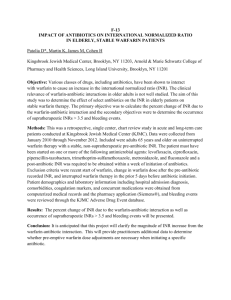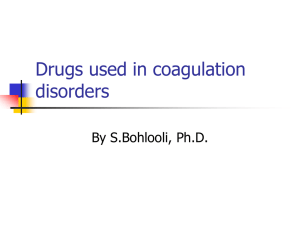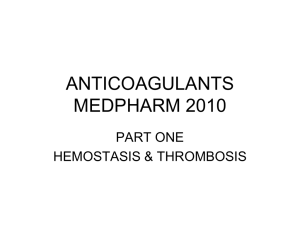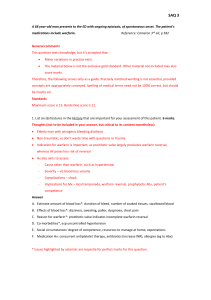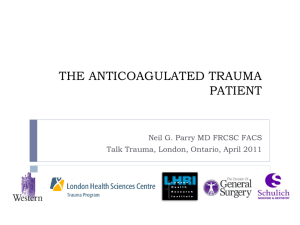answer key - Neel Raya MD
advertisement
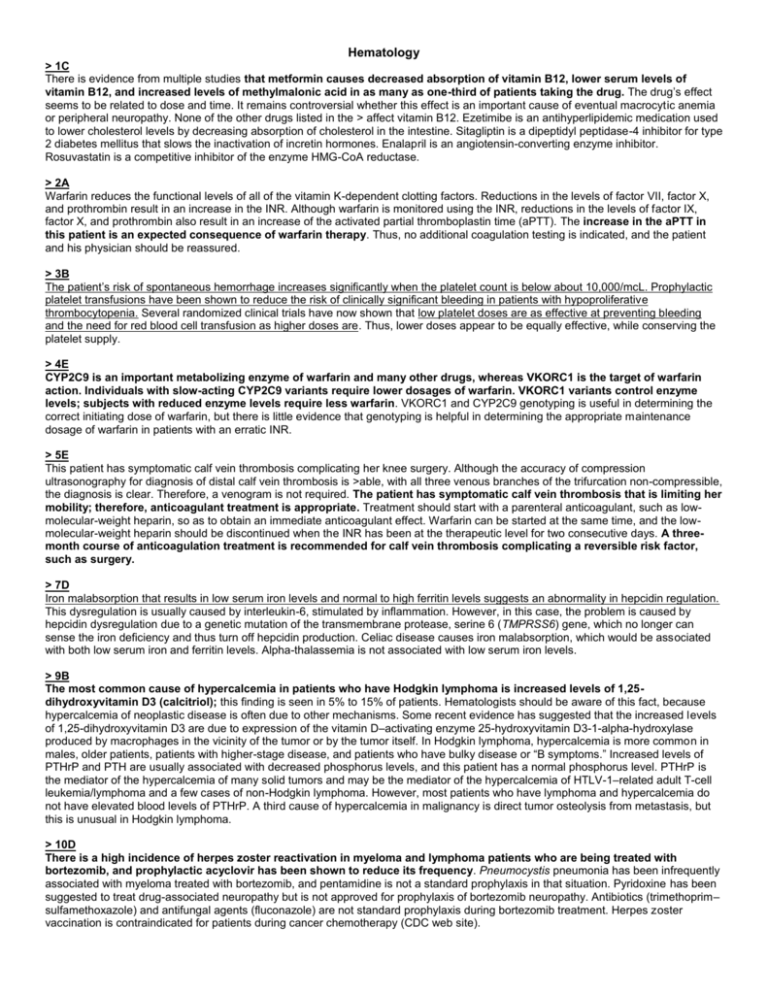
Hematology > 1C There is evidence from multiple studies that metformin causes decreased absorption of vitamin B12, lower serum levels of vitamin B12, and increased levels of methylmalonic acid in as many as one-third of patients taking the drug. The drug’s effect seems to be related to dose and time. It remains controversial whether this effect is an important cause of eventual macrocytic anemia or peripheral neuropathy. None of the other drugs listed in the > affect vitamin B12. Ezetimibe is an antihyperlipidemic medication used to lower cholesterol levels by decreasing absorption of cholesterol in the intestine. Sitagliptin is a dipeptidyl peptidase-4 inhibitor for type 2 diabetes mellitus that slows the inactivation of incretin hormones. Enalapril is an angiotensin-converting enzyme inhibitor. Rosuvastatin is a competitive inhibitor of the enzyme HMG-CoA reductase. > 2A Warfarin reduces the functional levels of all of the vitamin K-dependent clotting factors. Reductions in the levels of factor VII, factor X, and prothrombin result in an increase in the INR. Although warfarin is monitored using the INR, reductions in the levels of factor IX, factor X, and prothrombin also result in an increase of the activated partial thromboplastin time (aPTT). The increase in the aPTT in this patient is an expected consequence of warfarin therapy. Thus, no additional coagulation testing is indicated, and the patient and his physician should be reassured. > 3B The patient’s risk of spontaneous hemorrhage increases significantly when the platelet count is below about 10,000/mcL. Prophylactic platelet transfusions have been shown to reduce the risk of clinically significant bleeding in patients with hypoproliferative thrombocytopenia. Several randomized clinical trials have now shown that low platelet doses are as effective at preventing bleeding and the need for red blood cell transfusion as higher doses are. Thus, lower doses appear to be equally effective, while conserving the platelet supply. > 4E CYP2C9 is an important metabolizing enzyme of warfarin and many other drugs, whereas VKORC1 is the target of warfarin action. Individuals with slow-acting CYP2C9 variants require lower dosages of warfarin. VKORC1 variants control enzyme levels; subjects with reduced enzyme levels require less warfarin. VKORC1 and CYP2C9 genotyping is useful in determining the correct initiating dose of warfarin, but there is little evidence that genotyping is helpful in determining the appropriate maintenance dosage of warfarin in patients with an erratic INR. > 5E This patient has symptomatic calf vein thrombosis complicating her knee surgery. Although the accuracy of compression ultrasonography for diagnosis of distal calf vein thrombosis is >able, with all three venous branches of the trifurcation non-compressible, the diagnosis is clear. Therefore, a venogram is not required. The patient has symptomatic calf vein thrombosis that is limiting her mobility; therefore, anticoagulant treatment is appropriate. Treatment should start with a parenteral anticoagulant, such as lowmolecular-weight heparin, so as to obtain an immediate anticoagulant effect. Warfarin can be started at the same time, and the lowmolecular-weight heparin should be discontinued when the INR has been at the therapeutic level for two consecutive days. A threemonth course of anticoagulation treatment is recommended for calf vein thrombosis complicating a reversible risk factor, such as surgery. > 7D Iron malabsorption that results in low serum iron levels and normal to high ferritin levels suggests an abnormality in hepcidin regulation. This dysregulation is usually caused by interleukin-6, stimulated by inflammation. However, in this case, the problem is caused by hepcidin dysregulation due to a genetic mutation of the transmembrane protease, serine 6 (TMPRSS6) gene, which no longer can sense the iron deficiency and thus turn off hepcidin production. Celiac disease causes iron malabsorption, which would be associated with both low serum iron and ferritin levels. Alpha-thalassemia is not associated with low serum iron levels. > 9B The most common cause of hypercalcemia in patients who have Hodgkin lymphoma is increased levels of 1,25dihydroxyvitamin D3 (calcitriol); this finding is seen in 5% to 15% of patients. Hematologists should be aware of this fact, because hypercalcemia of neoplastic disease is often due to other mechanisms. Some recent evidence has suggested that the increased levels of 1,25-dihydroxyvitamin D3 are due to expression of the vitamin D–activating enzyme 25-hydroxyvitamin D3-1-alpha-hydroxylase produced by macrophages in the vicinity of the tumor or by the tumor itself. In Hodgkin lymphoma, hypercalcemia is more common in males, older patients, patients with higher-stage disease, and patients who have bulky disease or “B symptoms.” Increased levels of PTHrP and PTH are usually associated with decreased phosphorus levels, and this patient has a normal phosphorus level. PTHrP is the mediator of the hypercalcemia of many solid tumors and may be the mediator of the hypercalcemia of HTLV-1–related adult T-cell leukemia/lymphoma and a few cases of non-Hodgkin lymphoma. However, most patients who have lymphoma and hypercalcemia do not have elevated blood levels of PTHrP. A third cause of hypercalcemia in malignancy is direct tumor osteolysis from metastasis, but this is unusual in Hodgkin lymphoma. > 10D There is a high incidence of herpes zoster reactivation in myeloma and lymphoma patients who are being treated with bortezomib, and prophylactic acyclovir has been shown to reduce its frequency. Pneumocystis pneumonia has been infrequently associated with myeloma treated with bortezomib, and pentamidine is not a standard prophylaxis in that situation. Pyridoxine has been suggested to treat drug-associated neuropathy but is not approved for prophylaxis of bortezomib neuropathy. Antibiotics (trimethoprim– sulfamethoxazole) and antifungal agents (fluconazole) are not standard prophylaxis during bortezomib treatment. Herpes zoster vaccination is contraindicated for patients during cancer chemotherapy (CDC web site). > 12E This patient has vitamin K deficiency. Vitamin K is a fat-soluble vitamin. This patient’s recent hepatobiliary surgery may have impaired vitamin K absorption, while the broad-spectrum antibiotics and subsequent alteration in gut flora may have reduced vitamin K production. Vitamin K deficiency results in a decrease in the functional levels of factor VII, factor X, and prothrombin, which explains the increase in the INR and a decrease in the levels of factor IX, factor X, and prothrombin, which in turn explains the prolonged aPTT. The normal platelet count and fibrinogen level exclude disseminated intravascular coagulation. Acquired prothrombin deficiency is very rare. Nonspecific lupus anticoagulants are rarely associated with bleeding. > 14B This patient has an acquired inhibitor to factor VIII and is bleeding. The best option to stop the bleeding is recombinant factor VIIa; activated prothrombin complex concentrate would be another alternative. Both can induce thrombotic events. Fresh frozen plasma will not be beneficial because the factor VIII will be neutralized by the antibody. Desmopressin may temporarily increase factor VIII levels but is unlikely to be sufficient in this case. After bleeding is controlled, the next step is to eliminate the inhibitor. For this purpose, prednisone is often used as a first step. Promising results have also been reported with rituximab. > 17D Heparin-induced thrombocytopenia (HIT) is more common in surgical patients than in medical patients and more common in women than in men. Although HIT occurs more frequently with unfractionated heparin, it also can occur with low-molecular-weight heparin. Typically, thrombocytopenia develops five to ten days after the patient has started the heparin, and the platelet count decreases by 50% or more from the baseline value, as is the case here. If HIT is suspected, all heparin should be stopped (including heparin used to flush indwelling lines). The diagnosis should be established with immunoassays for antibodies against heparin/platelet factor 4 complexes, by functional assays for heparin-induced platelet aggregation or serotonin release, or by both. HIT is a hypercoagulable state, and thus an alternative anticoagulant should be started. Alternatives include direct thrombin inhibitors, such as argatroban or hirudin, or possibly fondaparinux, which is an indirect inhibitor of factor Xa. The normal INR and activated partial thromboplastin time (aPTT) make disseminated intravascular coagulation unlikely. > 19D Agents that induce increased enzymatic activity of the P450 system, and especially the CYP3A4 isozyme, can result in subtherapeutic blood levels of imatinib and thereby loss of response in chronic myeloid leukemia (CML). St. John’s wort is a potent inducer of P450 3A4 and is known to lower imatinib levels. Grapefruit juice, lovastatin, clarithromycin, and ketoconazole are known to inhibit the enzyme and may increase imatinib blood levels. A steady-state blood level of imatinib greater than 1000 ng/mL has been associated with better long-term clinical responses than have lower concentrations. > 22A Recurrent miscarriage is a major health problem; 5% of women of reproductive age have two or more miscarriages, and 1% have three or more. Most pregnancy losses are unexplained. Antiphospholipid antibody syndrome and some thrombophilias, such as the factor V Leiden or prothrombin gene mutations, are associated with miscarriages, presumably because of thrombosis in the developing trophoblast. Although studies using historical controls suggested that antithrombotic therapy with low-molecular-weight heparin, aspirin, or both may improve the outcome in women with a history of recurrent miscarriages, randomized, controlled trials have shown this not to be the case, at least for women who do not have thrombophilia. > 24B Levels of protein S are decreased in pregnancy and in the postpartum period. The reduction in protein S levels attenuates the anticoagulant effect of activated protein C and renders the activated protein C resistance assay abnormal. Therefore, the coagulation findings in this patient are likely physiologic and not indicative of protein S deficiency. Evidence-based practice guidelines recommend a three-month course of anticoagulation therapy for patients with deep vein thrombosis complicating a transient risk factor such as cesarean section. Tests for activated protein C resistance and free protein S can be repeated when warfarin has been discontinued. These tests should not be done while the patient is on warfarin because warfarin reduces the levels of protein S, which is a vitamin K-dependent protein.



